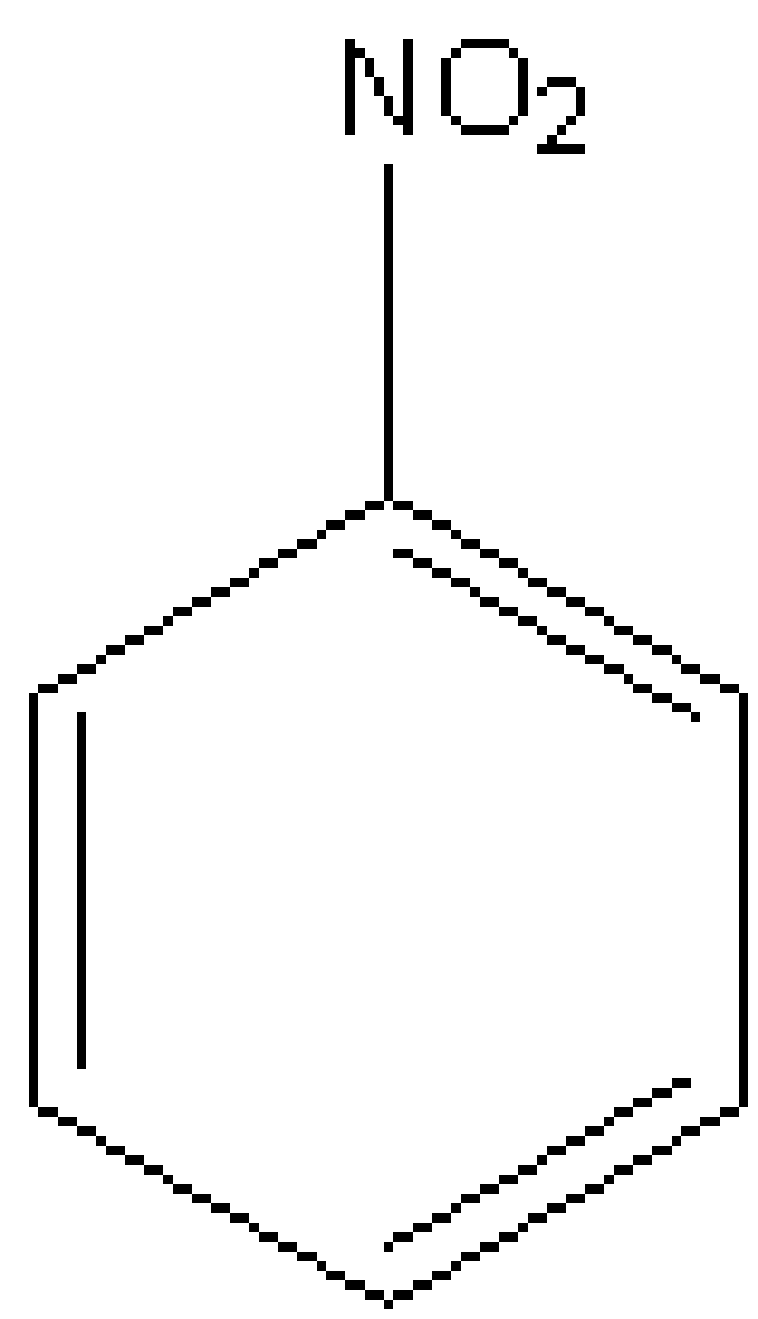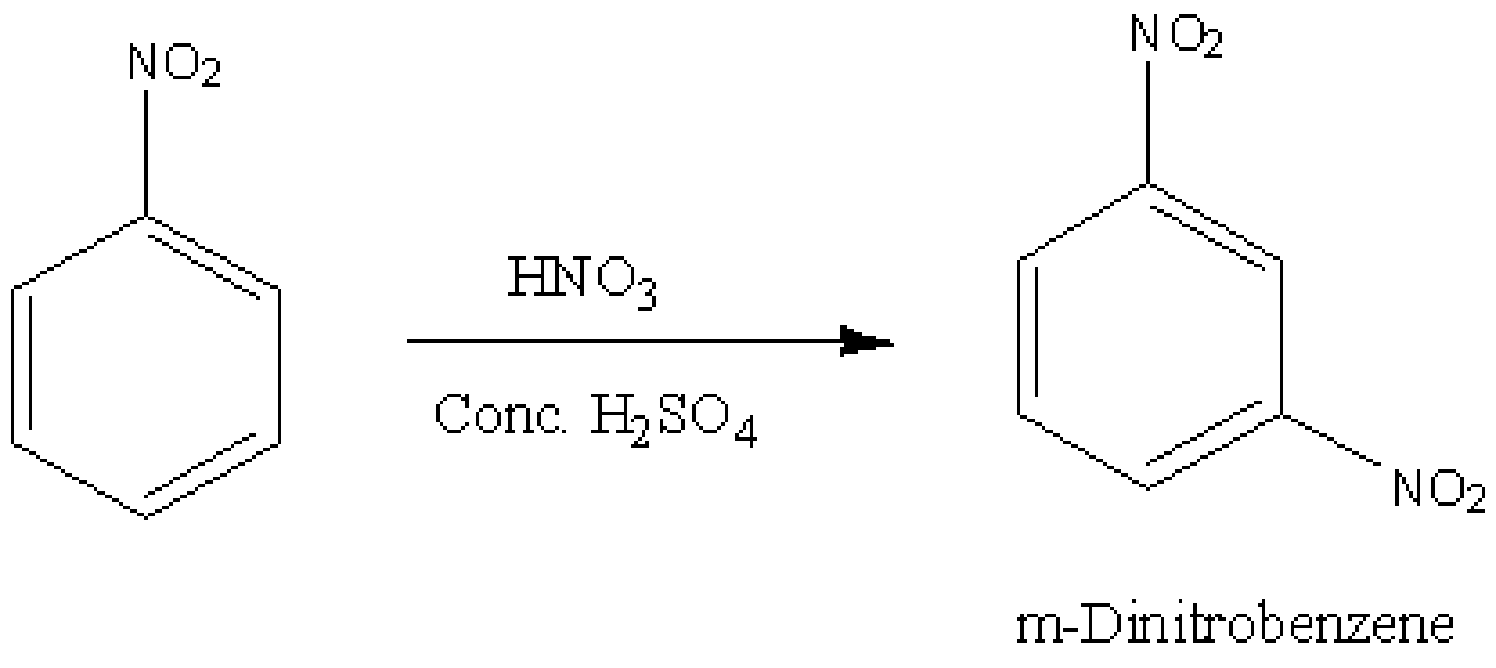
Nitrobenzene on further excessive nitration gives
A. Sym-trinitrobenzne
B. M-Dinitrobenzne
C. P-Dinitrobenzene
D. All of these
Answer
222k+ views
Hint: Nitration is a chemical process by which nitro group (s) are introduced to a chemical compound. Nitration can be done by reacting benzene with \[{\rm{HN}}{{\rm{O}}_{\rm{3}}}\] (nitric acid ) in presence of sulphuric acid (\[{{\rm{H}}_{\rm{2}}}{\rm{S}}{{\rm{O}}_{\rm{4}}}\]).
Complete Step by Step Solution:
Let's discuss nitrobenzene first. Nitrobenzene is a chemical species possessing the chemical formula of\[{{\rm{C}}_{\rm{6}}}{{\rm{H}}_{\rm{5}}}{\rm{N}}{{\rm{O}}_{\rm{2}}}\] . It shows the insolubility in water. It is A pale yellow coloured oil possessing the odour of almond. Freezing of it gives green-yellow coloured crystals. It is manufactured in huge quantities from benzene. The structure of nitrobenzene is,

Image: Nitrobenzene
Here, we have to find out the product which is produced when excessive nitration of nitrobenzene occurs.
Here, nitrobenzene undergoes excessive nitration. When nitrobenzene undergoes a reaction with nitric acid in presence of sulphuric acid, the following reaction occurs.
\[{\rm{HN}}{{\rm{O}}_{\rm{3}}} + {{\rm{H}}_{\rm{2}}}{\rm{S}}{{\rm{O}}_{\rm{4}}} \to {\rm{N}}{{\rm{O}}_{\rm{2}}}^ + + {{\rm{H}}_{\rm{2}}}{\rm{O}} + {\rm{HS}}{{\rm{O}}_{\rm{4}}}^ - \]
Although \[{\rm{HN}}{{\rm{O}}_{\rm{3}}}\] is an acid, in the above reaction, it acts as a base and \[{{\rm{H}}_{\rm{2}}}{\rm{S}}{{\rm{O}}_{\rm{4}}}\] acts as an acid. And we know, nitro group is an meta directing and deactivating group. Therefore, the product obtained is,

Image: Nitration of nitrobenzene
Further nitration of nitration is not possible because of the deactivating nitro group.
Hence, the option B is right.
Note: Nitration of benzene takes place in three steps, First step is, Activation of the electrophile by the acid. Second step is an attack of the activated electrophile by benzene and the last step is deprotonation to restore the aromatic ring and regeneration of the acidic catalyst.
Complete Step by Step Solution:
Let's discuss nitrobenzene first. Nitrobenzene is a chemical species possessing the chemical formula of\[{{\rm{C}}_{\rm{6}}}{{\rm{H}}_{\rm{5}}}{\rm{N}}{{\rm{O}}_{\rm{2}}}\] . It shows the insolubility in water. It is A pale yellow coloured oil possessing the odour of almond. Freezing of it gives green-yellow coloured crystals. It is manufactured in huge quantities from benzene. The structure of nitrobenzene is,

Image: Nitrobenzene
Here, we have to find out the product which is produced when excessive nitration of nitrobenzene occurs.
Here, nitrobenzene undergoes excessive nitration. When nitrobenzene undergoes a reaction with nitric acid in presence of sulphuric acid, the following reaction occurs.
\[{\rm{HN}}{{\rm{O}}_{\rm{3}}} + {{\rm{H}}_{\rm{2}}}{\rm{S}}{{\rm{O}}_{\rm{4}}} \to {\rm{N}}{{\rm{O}}_{\rm{2}}}^ + + {{\rm{H}}_{\rm{2}}}{\rm{O}} + {\rm{HS}}{{\rm{O}}_{\rm{4}}}^ - \]
Although \[{\rm{HN}}{{\rm{O}}_{\rm{3}}}\] is an acid, in the above reaction, it acts as a base and \[{{\rm{H}}_{\rm{2}}}{\rm{S}}{{\rm{O}}_{\rm{4}}}\] acts as an acid. And we know, nitro group is an meta directing and deactivating group. Therefore, the product obtained is,

Image: Nitration of nitrobenzene
Further nitration of nitration is not possible because of the deactivating nitro group.
Hence, the option B is right.
Note: Nitration of benzene takes place in three steps, First step is, Activation of the electrophile by the acid. Second step is an attack of the activated electrophile by benzene and the last step is deprotonation to restore the aromatic ring and regeneration of the acidic catalyst.
Recently Updated Pages
Types of Solutions in Chemistry: Explained Simply

States of Matter Chapter For JEE Main Chemistry

Difference Between Alcohol and Phenol: Structure, Tests & Uses

Conduction Explained: Definition, Examples & Science for Students

Balancing of Redox Reactions - Important Concepts and Tips for JEE

Atomic Size - Important Concepts and Tips for JEE

Trending doubts
JEE Main 2026: Application Form Open, Exam Dates, Syllabus, Eligibility & Question Papers

Derivation of Equation of Trajectory Explained for Students

Hybridisation in Chemistry – Concept, Types & Applications

Understanding the Angle of Deviation in a Prism

How to Convert a Galvanometer into an Ammeter or Voltmeter

Degree of Dissociation: Meaning, Formula, Calculation & Uses

Other Pages
Solutions Class 12 Chemistry Chapter 1 CBSE Notes - 2025-26

NCERT Solutions For Class 12 Chemistry Chapter 1 Solutions - 2025-26

The D and F Block Elements Class 12 Chemistry Chapter 4 CBSE Notes - 2025-26

NCERT Solutions for Class 12 Chemistry Chapter Chapter 7 Alcohol Phenol and Ether

NCERT Solutions ForClass 12 Chemistry Chapter Chapter 8 Aldehydes Ketones And Carboxylic Acids

JEE Advanced Marks vs Ranks 2025: Understanding Category-wise Qualifying Marks and Previous Year Cut-offs




